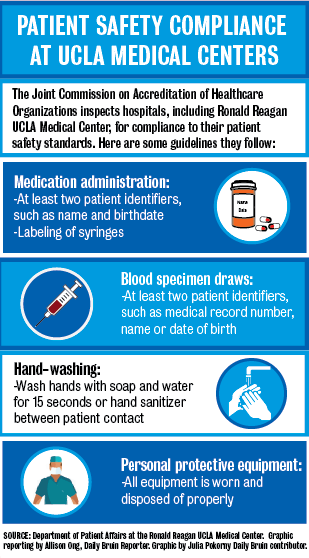Volunteers seek to improve patient safety at UCLA medical centers

By Allison Ong
May 17, 2016 11:00 p.m.
During a typical volunteer shift at Ronald Reagan UCLA Medical Center, Melinda Ng patrols the clinic floors to ensure nurses, physicians and surgeons wash their hands with soap for at least 15 seconds before rinsing.
Ng, a fourth-year biochemistry student, is a leader of Measuring to Achieve Patient Safety, or MAPS, a student organization that helps the hospital maintain a hygienic and safe environment for its patients.
A Johns Hopkins University study published May 3 in The BMJ claims medical errors are the third leading cause of death in the United States behind heart disease and cancer, with up to 250,000 annual deaths. The term “medical errors” includes in-hospital mistakes such as unrecognized surgical complications and medication mislabeling, researchers said.
Hospital Safety Score gave Ronald Reagan UCLA Medical Center a C grade this spring in patient safety, with low scores for in-house infections, patient falls and some surgical complications. The UCLA medical center received higher ratings in areas such as prevention of ventilator problems, communications about medication and hand-washing hygiene.
MAPS, which hopes to use student-collected data to improve these standards for patients hospitalwide, is the only group of its kind at Ronald Reagan UCLA Medical Center to actively monitor patient safety practices, said Cait Walsh, clinical safety supervisor and director of MAPS.
The organization, founded in 2006, sends students on two-hour rounds through Ronald Reagan UCLA Medical Center and UCLA Medical Center, Santa Monica to perform audits on clinical procedures. By analyzing data, the hospital can correct unhygienic practices in preparation for routine surveys and accreditation renewal, Walsh said.
“Patients and their families are so much more savvy of what their rights are today,” Walsh said. “Good hand hygiene is very important to them, and many will point out to staff if they see improper hand hygiene.”
During their shifts, volunteers walk unit to unit observing clinical procedures for safety auditing. The team, composed of about 80 undergraduate and graduate students, ensures staff wears personal protective equipment properly, grabs clean tubes for blood draws and disposes used needles. Volunteers also help prevent medication mix-ups by checking that nurses identify patients using two unique identifiers, such as their name and medical record number, Ng said.
Audits ensure the hospital is in compliance with quality standards required for renewing hospital accreditation and receiving funds, Walsh said. Members log noncompliance incidents into a mobile application designed specifically for MAPS.
Volunteers perform as many as 8,000 audits monthly, Ng added. MAPS data is aggregated and sent to charge nurses and department heads who address noncompliances with personnel, Walsh said. Once a year, MAPS interns present data at clinical meetings and discuss ways to improve patient safety.
MAPS also launched the Fall Ambassador Program in 2012 to help reduce the number of in-hospital falls. Ambassadors identify elderly patients at high risk for accidental falls and leave a gold sticker on the patient’s door, said Ng, who leads the program. The stickers remind nurses to keep an open line of sight to the patients and assist them when necessary.
“When I was in high school, my grandma fell down the stairs,” Ng said. “I saw how the outcome of a simple injury could lead to a life-changing experience.”
Walsh said she thinks MAPS has led to a decrease in safety violations over the years.
“In 2006, when we started in the Center for Health Sciences, lots of staff didn’t like to be watched, but now everyone is on board,” she said. “A positive effect is that hand-washing is (now) ingrained in the hospital’s culture.”
UCLA has seen several safety breaches over the past five years, including the superbug outbreak last year and a 2011 incident in which a sponge was left in a patient’s body after surgery.
In an incident report, UCLA officials announced a large-scale implementation of SurgiCount Initiative, a barcode system that helps personnel track sponges electronically during surgery. The hospital’s Clinical Epidemiology and Infection Control department also carries out projects intended to reduce catheter-associated infections and surgical site infections caused by exposure to harmful microorganisms, according to the department’s website.
The hospital continues to search for ways to improve patient experience, said Robert Cherry, chief medical and quality officer of UCLA Health, in an email statement. Existing practices include disinfection of surfaces with ultraviolet light and usage of medication dispensers.
A new MAPS project aims to see if hand-washing policies are followed even when personnel are unaware they’re being watched, since improper hand-washing is the most frequently reported incident, Walsh said.
“Even if you’re a physician … you could be carrying infections into the room through germs,” she said. “You want to be a healer, not a bearer of microbes.”
Email Ong at [email protected] or tweet her at @allison_ong7.


